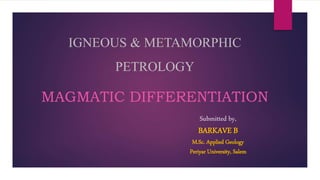Magmatic Differentiation.pptx
- 1. IGNEOUS & METAMORPHIC PETROLOGY MAGMATIC DIFFERENTIATION Submitted by, BARKAVE B M.Sc. Applied Geology Periyar University, Salem
- 2. INTRODUCTION The defining characteristic of Igneous Rocks is that at one time they were molten and part of magmas or lavas. A Magma is a body of molten siliceous substance which contains water vapour and volatile substances that occurs below the surface of the earth. When magma rises along a deep fault and pours out on the earth's surface, it is termed Lava. This molten material then cooled to form a variety of intrusive and extrusive igneous rocks. When a magma cools, chemical reactions occur that create a series of different minerals. The process of differentiation of magma occurs.
- 3. Magmatic Differentiation Magmatic differentiation is a complex process whereby a single melt can produce a wide variety of different igneous rocks. If magmas are related to each other by some processes, that process would have to be one that causes magma composition to change. Any process that causes magma composition to change is called magmatic differentiation.
- 4. Cont. The process of magmatic differentiation or geochemical evolution of magmas beneath the volcanic arcs results in the formation of relatively high-silica andesitic or rhyolitic magmas that solidify as low-density rocks.
- 5. MECHANISMS OF MAGMA DIVERSIFICATION (DIFFERENTIATION) Over the years, various process have been suggested to explain the variation of magma compositions observed within small regions. Among the processes are: Distinct melting events from distinct sources Various degrees of partial melting from the same source Crystal fractionation Mixing of two or more magmas Assimilation or contamination of magmas by crustal rocks Liquid Immiscibility
- 6. Cont. The process of differentiation occurs along two branches: Discontinuous and Continuous. These theories were first proven in the laboratory by N. L. Bowen in the early 1900s and are also known as Bowen's reaction series. The progression in the series explains why the first lavas from a volcanic vent are rich in iron, magnesium, and calcium, are low in quartz, and are dark green to black and why the later lavas are lighter colored and contain more quartz.
- 8. DISCONTINUOUS BRANCH The minerals that form in the discontinuous branch are all ferromagnesian—that is, they contain high percentages of iron and magnesium, which impart a dark green to black color. The branch is called discontinuous because the minerals form at discrete temperatures and not continuously during cooling. The first mineral to crystallize is olivine, followed by pyroxene, amphibole, and biotite.
- 9. CONTINUOUS BRANCH The Continuous branch is made up of the plagioclase feldspars. The calcium or sodium ratio in this mineral type changes continuously as the magma cools. The first feldspars to form contain the highest amounts of calcium; subsequent feldspars have progressively less calcium and more sodium. These minerals tend to be pink, tan, brown, or whitish. Any magma left over after all these reactions have been completed crystallizes at the lowest temperature as quartz
- 10. CONCLUSION Differentiation is the process by which magmas evolve to give rise to a variety of magmas and rock types (that have different compositions). Therefore, certain physical processes are required to cause the chemical diversification of a magma. Most melts develop in the lower crust or in the asthenosphere (upper mantle), so, such melts have a primitive mafic or basaltic composition, whereas melts developing in the upper crust have a higher initial silica content.
